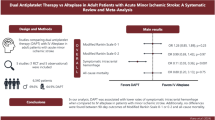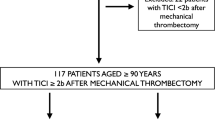Abstract
Background
Severe intracranial atherosclerotic stenosis (ICAS) is a major cause of stroke. Although percutaneous transluminal angioplasty and stenting (PTAS) treatment methods have increased over the last decade as alternative therapies, there is debate regarding the best method of treatment, with medical and surgical therapies often suggested.
Methods
We analyzed the long-term follow-up results from 5 years of intracranial stenting for intracranial stenosis from three stroke centers. The primary endpoints were early stroke complications or death within 30 days after stent insertion, and the secondary endpoint was a recurrent stroke between 30 days and 60 months. Correlating factors and Kaplan–Meier survival curves for recurrent stroke and in-stent restenosis (ISR) were also obtained.
Results
Seventy-three PTAS in 71 patients were examined in this study. The primary and secondary endpoints were all 8.2% (n = 6), and restenosis was 13.7% (n = 10) during the 5-year follow-up. The primary endpoints were significantly frequent in the high National Institutes of Health Stroke Scale (NIHSS) and early stent (≤ 7 days after dual antiplatelet medication) groups. Secondary endpoint and ISR were identically frequent in the younger age group and in the presence of tandem stenosis in other major intracranial arteries. The cumulative probability of recurrent stroke and ISR at 60 months was 16.4% and 14.1%, respectively.
Conclusions
This study shows that PTAS is safe and effective for major ICAS. Reducing the early complication rate is still an important factor, despite the fact that long-term stroke recurrence was low.




Similar content being viewed by others
References
Alexander MJ, Zauner A, Chaloupka JC, Baxter B, Callison RC, Gupta R, Song SS, Yu W (2019) WEAVE trial: final results in 152 on-label patients. Stroke 50:889–894. https://doi.org/10.1161/strokeaha.118.023996
Bose A, Hartmann M, Henkes H, Liu HM, Teng MM, Szikora I, Berlis A, Reul J, Yu SC, Forsting M, Lui M, Lim W, Sit SP (2007) A novel, self-expanding, nitinol stent in medically refractory intracranial atherosclerotic stenoses: the Wingspan study. Stroke 38:1531–1537. https://doi.org/10.1161/strokeaha.106.477711
Chimowitz MI, Lynn MJ, Derdeyn CP, Turan TN, Fiorella D, Lane BF, Janis LS, Lutsep HL, Barnwell SL, Waters MF, Hoh BL, Hourihane JM, Levy EI, Alexandrov AV, Harrigan MR, Chiu D, Klucznik RP, Clark JM, McDougall CG, Johnson MD, Pride GL Jr, Torbey MT, Zaidat OO, Rumboldt Z, Cloft HJ (2011) Stenting versus aggressive medical therapy for intracranial arterial stenosis. N Engl J Med 365:993–1003. https://doi.org/10.1056/NEJMoa1105335
Chimowitz MI, Lynn MJ, Howlett-Smith H, Stern BJ, Hertzberg VS, Frankel MR, Levine SR, Chaturvedi S, Kasner SE, Benesch CG, Sila CA, Jovin TG, Romano JG (2005) Comparison of warfarin and aspirin for symptomatic intracranial arterial stenosis. N Engl J Med 352:1305–1316. https://doi.org/10.1056/NEJMoa043033
Compter A, van der Worp HB, Schonewille WJ, Vos JA, Boiten J, Nederkoorn PJ, Uyttenboogaart M, Lo RT, Algra A, Kappelle LJ (2015) Stenting versus medical treatment in patients with symptomatic vertebral artery stenosis: a randomised open-label phase 2 trial. Lancet Neurol 14:606–614. https://doi.org/10.1016/s1474-4422(15)00017-4
Derdeyn CP, Chimowitz MI, Lynn MJ, Fiorella D, Turan TN, Janis LS, Montgomery J, Nizam A, Lane BF, Lutsep HL, Barnwell SL, Waters MF, Hoh BL, Hourihane JM, Levy EI, Alexandrov AV, Harrigan MR, Chiu D, Klucznik RP, Clark JM, McDougall CG, Johnson MD, Pride GL Jr, Lynch JR, Zaidat OO, Rumboldt Z, Cloft HJ (2014) Aggressive medical treatment with or without stenting in high-risk patients with intracranial artery stenosis (SAMMPRIS): the final results of a randomised trial. Lancet 383:333–341. https://doi.org/10.1016/s0140-6736(13)62038-3
Fiorella D, Levy EI, Turk AS, Albuquerque FC, Niemann DB, Aagaard-Kienitz B, Hanel RA, Woo H, Rasmussen PA, Hopkins LN, Masaryk TJ, McDougall CG (2007) US multicenter experience with the wingspan stent system for the treatment of intracranial atheromatous disease: periprocedural results. Stroke 38:881–887. https://doi.org/10.1161/01.STR.0000257963.65728.e8
Kasner SE, Chimowitz MI, Lynn MJ, Howlett-Smith H, Stern BJ, Hertzberg VS, Frankel MR, Levine SR, Chaturvedi S, Benesch CG, Sila CA, Jovin TG, Romano JG, Cloft HJ (2006) Predictors of ischemic stroke in the territory of a symptomatic intracranial arterial stenosis. Circulation 113:555–563. https://doi.org/10.1161/circulationaha.105.578229
Markus HS, Larsson SC, Kuker W, Schulz UG, Ford I, Rothwell PM, Clifton A (2017) Stenting for symptomatic vertebral artery stenosis: the Vertebral Artery Ischaemia Stenting Trial. Neurology 89:1229–1236. https://doi.org/10.1212/wnl.0000000000004385
Park SC, Cho SH, Kim MK, Kim JE, Jang WY, Lee MK, Jo KD, You SH (2020) Long-term outcome of angioplasty using a Wingspan stent, post-stent balloon dilation and aggressive restenosis management for intracranial arterial stenosis. Clin Neuroradiol 30:159–169. https://doi.org/10.1007/s00062-019-00793-1
Qureshi AI, Feldmann E, Gomez CR, Johnston SC, Kasner SE, Quick DC, Rasmussen PA, Suri MF, Taylor RA, Zaidat OO (2009) Consensus conference on intracranial atherosclerotic disease: rationale, methodology, and results. J Neuroimaging 19(Suppl 1):1s–10s. https://doi.org/10.1111/j.1552-6569.2009.00414.x
Sacco RL, Kargman DE, Gu Q, Zamanillo MC (1995) Race-ethnicity and determinants of intracranial atherosclerotic cerebral infarction. The Northern Manhattan Stroke Study Stroke 26:14–20. https://doi.org/10.1161/01.str.26.1.14
Suri MF, Johnston SC (2009) Epidemiology of intracranial stenosis. J Neuroimaging 19(Suppl 1):11s–16s. https://doi.org/10.1111/j.1552-6569.2009.00415.x
Turk AS, Levy EI, Albuquerque FC, Pride GL Jr, Woo H, Welch BG, Niemann DB, Purdy PD, Aagaard-Kienitz B, Rasmussen PA, Hopkins LN, Masaryk TJ, McDougall CG, Fiorella D (2008) Influence of patient age and stenosis location on wingspan in-stent restenosis. AJNR Am J Neuroradiol 29:23–27. https://doi.org/10.3174/ajnr.A0869
Wang T, Yang K, Luo J, Gao P, Ma Y, Wang Y, Li L, Liu Y, Feng Y, Wang X, Jiao L (2020) Outcomes after stenting for symptomatic intracranial arterial stenosis: a systematic review and meta-analysis. J Neurol 267:581–590. https://doi.org/10.1007/s00415-018-09176-x
White H, Boden-Albala B, Wang C, Elkind MS, Rundek T, Wright CB, Sacco RL (2005) Ischemic stroke subtype incidence among whites, blacks, and Hispanics: the Northern Manhattan Study. Circulation 111:1327–1331. https://doi.org/10.1161/01.Cir.0000157736.19739.D0
Wityk RJ, Lehman D, Klag M, Coresh J, Ahn H, Litt B (1996) Race and sex differences in the distribution of cerebral atherosclerosis. Stroke 27:1974–1980. https://doi.org/10.1161/01.str.27.11.1974
Wong KS, Huang YN, Gao S, Lam WW, Chan YL, Kay R (1998) Intracranial stenosis in Chinese patients with acute stroke. Neurology 50:812–813. https://doi.org/10.1212/wnl.50.3.812
Wong LK (2006) Global burden of intracranial atherosclerosis. Int J Stroke 1:158–159. https://doi.org/10.1111/j.1747-4949.2006.00045.x
Yu W, Jiang WJ (2018) Stenting for intracranial stenosis: potential future for the prevention of disabling or fatal stroke. Stroke Vasc Neurol 3:140–146. https://doi.org/10.1136/svn-2018-000158
Zaidat OO, Fitzsimmons BF, Woodward BK, Wang Z, Killer-Oberpfalzer M, Wakhloo A, Gupta R, Kirshner H, Megerian JT, Lesko J, Pitzer P, Ramos J, Castonguay AC, Barnwell S, Smith WS, Gress DR (2015) Effect of a balloon-expandable intracranial stent vs medical therapy on risk of stroke in patients with symptomatic intracranial stenosis: the VISSIT randomized clinical trial. JAMA 313:1240–1248. https://doi.org/10.1001/jama.2015.1693
Zaidat OO, Klucznik R, Alexander MJ, Chaloupka J, Lutsep H, Barnwell S, Mawad M, Lane B, Lynn MJ, Chimowitz M (2008) The NIH registry on use of the Wingspan stent for symptomatic 70–99% intracranial arterial stenosis. Neurology 70:1518–1524. https://doi.org/10.1212/01.wnl.0000306308.08229.a3
Zhao T, Zhu WY, Xiong XY, Li J, Wang L, Ding HY, Wei F, Zhou Y, Gong ZL, Cheng SY, Liu Y, Shuai J, Yang QW (2016) Safety and efficacy of Wingspan stenting for severe symptomatic atherosclerotic stenosis of the middle cerebral artery: analysis of 278 continuous cases. J Stroke Cerebrovasc Dis 25:2368–2372. https://doi.org/10.1016/j.jstrokecerebrovasdis.2016.05.035
Author information
Authors and Affiliations
Corresponding author
Ethics declarations
Ethical approval
For this type of study (retrospective), formal consent is not required.
Conflict of interest
The authors declare no competing interests.
Additional information
Publisher's Note
Springer Nature remains neutral with regard to jurisdictional claims in published maps and institutional affiliations.
This article is part of the Topical Collection on Vascular Neurosurgery-Ischemia
Rights and permissions
About this article
Cite this article
Park, S.K., Suh, S.H., Jang, K.S. et al. Long-term clinical and angiographic outcome from angioplasty and stenting for intracranial stenosis. Acta Neurochir 164, 1627–1634 (2022). https://doi.org/10.1007/s00701-022-05110-3
Received:
Accepted:
Published:
Issue Date:
DOI: https://doi.org/10.1007/s00701-022-05110-3




